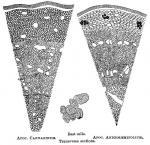The Roots of Apocynum Androsaemifolium and Apoc. Cannabinum.
BY EDWARD ADOLPHUS MANHEIMER, PH.G.
From an Inaugural Essay.
The close botanical relation of the two plants named suggested a microscopic examination of their roots, both of which are recognized by the pharmacopoeia as medicinal agents. The root of Apocynum cannabinum was easily procured in commerce and identified by Prof. Maisch. A number of wholesale drug houses were applied to for the root of Apoc. androsaemifolium, but invariably a substitute was furnished, proving to be the root of Apoc. cannabinum or of a plant closely allied to it. A genuine specimen, however, was procured from the collection of Prof. Maisch.
The two plants, which resemble each other, are indigenous to the United States; but the Apoc. androsaemifolium, or dog's-bane, grows chiefly in the northern part, while the other species, called Indian Hemp, is common in the southern part of the country.
The root of dog's-bane is long, about 1/8 or 1/4 inch thick, somewhat branched, externally dark brown, internally white. The bark is thin, longitudinally wrinkled, somewhat fissured transversely and is readily separated from the wood; the cambium line in the dry root is quite indistinct. The wood is fibrous and tenacious and encloses a pith of the same width as the bark, or even broader, and surrounded by a distinct medullary sheath. The wood is almost tasteless, while the bark has an unpleasant taste.
The root of Indian hemp is horizontal, several feet long and appears in the market in pieces varying in thickness from 1/8 to about 3/4 inch. The bark is brown-gray, deeply wrinkled and transversely fissured, about one-fifth the width of the root, and in the dry state has an indistinct cambium line. The wood is yellowish, soft, porous, more particularly in the outer portion, breaks readily with a smooth even fracture, and has no, or only a minute pith. Both bark and wood have a bitter taste, but that of the former is more persistent. The stems, which are sometimes mixed with the root, have a smooth red-brown bark, which is not very thick, and a pith which has generally disappeared, leaving the stem hollow; they have a slight sweetish taste.
 Under the microscope, the dog's-bane shows in the pith a few vessels and much starch; the cells are largest near the centre and are more or less compressed towards the wood, which is traversed by many medullary rays and contains, chiefly in the outer portion, a number of vessels. The bark is composed of oblong cells, differing in size and containing starch; a few laticiferous vessels are seen and several groups of thick-walled bast cells, arranged somewhat in a circle near the middle of the bark.
Under the microscope, the dog's-bane shows in the pith a few vessels and much starch; the cells are largest near the centre and are more or less compressed towards the wood, which is traversed by many medullary rays and contains, chiefly in the outer portion, a number of vessels. The bark is composed of oblong cells, differing in size and containing starch; a few laticiferous vessels are seen and several groups of thick-walled bast cells, arranged somewhat in a circle near the middle of the bark.
The root of Apoc. cannabinum shows, in the transverse section, in the centre a few small round cells. Then follows the wood, showing about three annual layers, vessels somewhat arranged in rows, and many medullary rays running into the bark. The cells of the bark are roundish, contain an abundance of starch and also numerous laticiferous vessels.
The author also examined microscopically the root that had been sold to him as that of Ap. androsaemifolium, and found it in most respects to agree physically and microscopically with the root of Apoc. cannabinum examined by him, the differences observed (two circles of wood, curved medullary rays, etc.) being of no importance. It is quite likely that nearly all the fluid extract of Apoc. androsaemifolium which is sold in our market has been made of this substitute or of Apocynum cannabinum.
The American Journal of Pharmacy, Vol. 53, 1881, was edited by John M. Maisch.

